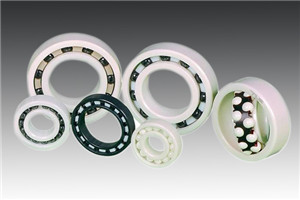Ceramic Bearings models
Feature
Total 1 Page 2 records

Features:
We have 2 types of ceramic bearing, hybrid ceramic bearing and full ceramic bearing, the hybrid ceramic bearing has steel inner and outer rings with ceramic balls, as for the full ceramic bearing; the inner, outer rings and the balls are made of ceramic. There are many kinds of ceramic materials, the most common ceramic materials are Si3N4 that stands for the silicon nitride ceramic material and is black colored, SiC stands for the silicon carbide material and also is black colored. and the ZrO2 that stands for the zirconium dioxide, also known as zirconia or zirconium oxide, they are white colored, a ZrO2 ball looks exactly like a pearl. the ceramic material is not stronger than steel, but ceramic bearing are lighter and have lower friction than steel, that makes ceramic bearing go faster with lower heat generated.
Ceramic bearing features:
1) essentially increased life time
2) high stiffness because of high Young’s modulus,lower vibration
3) wear resistance and cost effective lubrication
4) electrical insulation and non-magnetism
5) high temperature resistance up to 1000oC
6) high corrosion resistance to most acids and alkalies
■ Si3N4 material ceramic bearings:
Silicon Nitride (Si3N4) Ceramic Bearings are suitable for applications where high loads, high speeds and extreme temeratures are factors. Long life and the need for minimal lubrication make this material appropriate for extreme applications. Silicon Nitirde is non-porous, non-magentic, non corrosive and lighter than steel. In ball form, ceramic balls are also harder than steel and because ceramic balls are non-porous they are virtually frictionless. and capable of spinning faster than steel balls. Maximum useful temperature of Silicon Nitirde is 2552°F or 1400°C.
■ ZrO2 material ceramic bearings:
Zirconia is inert to corrosive materials, with the exception of hydrofloric acid and hot concentrated sulfuric acid. Zirconia is lighter than steel, non-magentic and has a maximum useful temperature of 400°C.
Parameter:
Comparision for ceramic bearing VS Chrome steel bearing:
| CERAMIC VS. STEEL | |||
|---|---|---|---|
| Item | Bearing Steel | Ceramics (SI3N4) |
Characteristics of Ceramic Bearings |
| Density (g/m?) | 7.8 | 3.2 |
Higher Speed Decreased centrifugal force Reduced Ball Skidding Lower Operating Temperature Less wear Less Friction |
| Heat Resistance (ºC) | 180 | 800 |
Maintains stability at high temperatures |
| Coefficient of linear thermal expansion (1/ºC) | 12.5 X 10?6 | 3.2 X 10?6 |
Minimal Ball Deformation Lower operating Temperature Stable Running Preload Reduced Contact Angle Change |
| Vicker's Hardness (HV) | 700~800 | 1400~1700 |
Reduced Ball/Race Contact Area Minimum Ball Deformation Less Friction More Rigid Less Wear Lower Operating Temperature |
| Young's Modulus (Gpa) | 206 | 314 | |
| Poisson's Ratio | .30 | .29 | |
| Magnetism | Ferromagnetic | Non-Magnetic | Reduced Torque in Strong Magnetic Field |
| Conductivity | Conductive | Non-Conductive |
No Electrical Arcing Through Balls Less Wear Reduced Race Way Pitting and Fluting |
| Corrosion Resistance | Not Good | Excellent |
Less Wear Harsh Environment Durability Longer Life |





